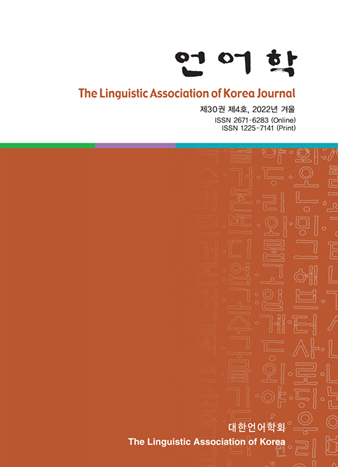대한언어학회 전자저널

30권 4호 (2022년 12월)
- An OT Analysis of Vowel Hiatus in the Jeju Dialect
-
Eunmi Lee & Hoonjoo Ko
Pages : 211-236
Abstract
Lee, Eunmi & Ko, Hoonjoo. (2022). An OT analysis of vowel hiatus in the Jeju dialect. The Linguistic Association of Korea Journal, 30(4), 211-236. This study is about the vowel hiatus resolutions resulting from suffixation in the Jeju dialect. To avoid the vowel hiatus, glide formation, glide insertion, and vowel deletion are adopted in the Jeju dialect. Glide insertion occurs at the morpheme boundary to break up the vowel sequence. The inserted segment is chosen depending on the feature of the stem final vowel. Glide insertion is not typical in standard Korean and other dialects in Korea but it is often spoken in a formal speech in the Jeju dialect. Glide formation also takes place in casual speech. Glide formation is the process where one of the vowels is substituted for the corresponding glide - the high vowel becomes [y] and the back round vowel becomes [w] at the morpheme boundary. This is where it is suppressed due to the Obligatory Contour Principle (Leben, 1973) related to the Consonant Glide (CG) cluster, and the lack of a high feature, required for glide formation. In each case, a deletion strategy is adopted, but which vowel is deleted between V1 and V2 is determined by both the sonority of the vowel and morphological factors such as the stem or suffix. We adopt constraints and their ranking for the analysis within the framework of Optimality Theory (OT). As all of the strategies are for the one goal - to avoid vowel hiatus, we provide a single constraint ranking that can explain various cases of vowel hiatus resolutions in the Jeju dialect.
Keywords
# verbal suffixation # vowel harmony # vowel hiatus # glide formation # glide insertion # vowel deletion # Optimality Theory
References
- 김원보. (1999). 제주방언에서의 동사어미 -an/-ən 교체현상. 음성 음운 형태론 연구, 5, 105-122.
- Casali, R. F. (1997). Vowel elision in hiatus contexts: Which vowel goes? Language, 73(3), 493-533.
- Cheon, S.-Y. (2002). Glides as consonants in Korean. Language Research, 38(2), 619-645.
- Clements, G. N., & Hume, E. V. (1995). The internal organization of speech sounds. The handbook of phonological theory, 7, 245-317.
- De Lacy, P. (2002). The interaction of tone and stress in Optimality Theory. Phonology, 19(1), 1-32.
- De Lacy, P. (2004). Markedness conflation in optimality theory. Phonology, 21(2), 145-199.
- Gim, C.-G. (1987). A study on syllable structure and some processes in its nucleus in Korean. Mal, 12, 25-69.
- Han, E.-J. (2009). Vowel harmony in hiatus contexts in Korean verbal morphology. Studies in Phonetics, Phonology, and Morphology, 15(2), 341-360.
- Hogg, R., & McCully, C. B. (1987). Metrical phonology: A course book. Cambridge: Cambridge University Press.
- Itô, J. (1989). A prosodic theory of epenthesis. Natural Language & Linguistic Theory, 7(2), 217-259.
- Jang, Y. (2016). Syllable contact and epenthesis in Yakut loanword phonology. Linguistic Research, 33(1), 39-64.
- Jun, J.-H. (2014). Hiatus resolution and opacity in Seoul Korean verbal paradigm. Studies in Phonetics, Phonology, and Morphology, 20(3), 379-401.
- Kager, R. (1999). Optimality theory. Cambridge: Cambridge University Press.
- Kang, H.-J. (2013). Phonetic grounding of position and height asymmetries in hiatus resolution. Studies in Phonetics, Phonology, and Morphology, 19(2), 217-232.
- Kang, O.-M. (1999). A correspondence approach to glide formation in Korean. Language, 24(4), 477-496.
- Kang, S.-H. (2009) Glide formation in Jeju dialect. Studies in Linguistics, 14(2), 19-36.
- Kenstowicz, M. (1997). Quality-sensitive stress. Rivista di Linguistica, 9, 157-188.
- Kim, C.-H. (1990). Umjol umunnon. Seoul: Hanshin Publishing Co.
- Kim, J . - K . (2000). Quantity-sensitivity and feature-sensitivity of vowels. Unpublished doctoral dissertation, Indiana University, Indiana.
- Kim, W.-B. (2002). The synchronic phonology of Jeju dialect. Studies in Linguistics, 7(1), 33-45.
- Lee, B.-G. (1982). A well-formedness condition on syllable structure. In I.-S. Yang (Ed.), Linguistics in the morning calm (pp. 489-506). Seoul, Korea: Hanshin Publishers.
- Lee, M.-K. (2018). English vowel hiatus and consonant epenthesis. Studies in English Language & Literature, 44(4), 89-110.
- Lee, Y.-S. (1993). Topics in the vowel phonology of Korean. Dissertation Abstracts International (96278) 1993 Oct; 54 (4): 1342A. Indiana University.
- Lee , Y .-S . (1996). Glide formation in Korean. Linguistics, 21(1,2), 465-482.
- Lehiste, I., & Peterson, G. E. (1959). Vowel amplitude and phonemic stress in American English. The Journal of the Acoustical Society of America, 31(4), 428-435.
- McCarthy, J. (1986). OCP effects: Gemination and antigemination. Linguistic Inquiry, 17(2), 207-263.
- Prince, A., & Smolensky, P. (1993). Optimality: Constraint interaction in generative grammar. Unpublished manuscript.